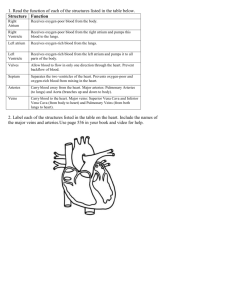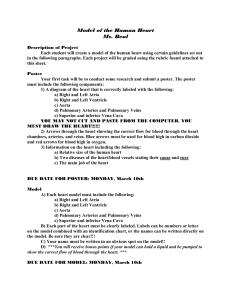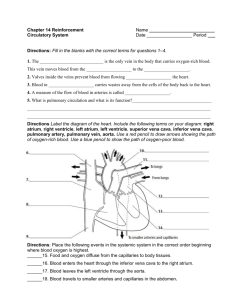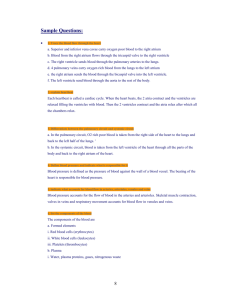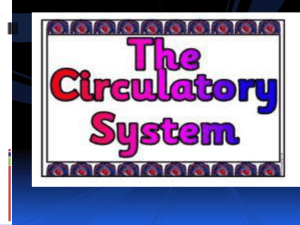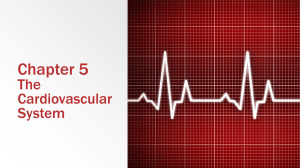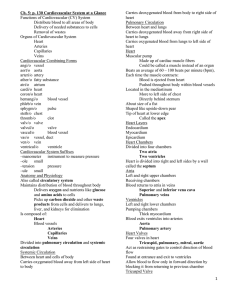The heart worsheet answrs
advertisement
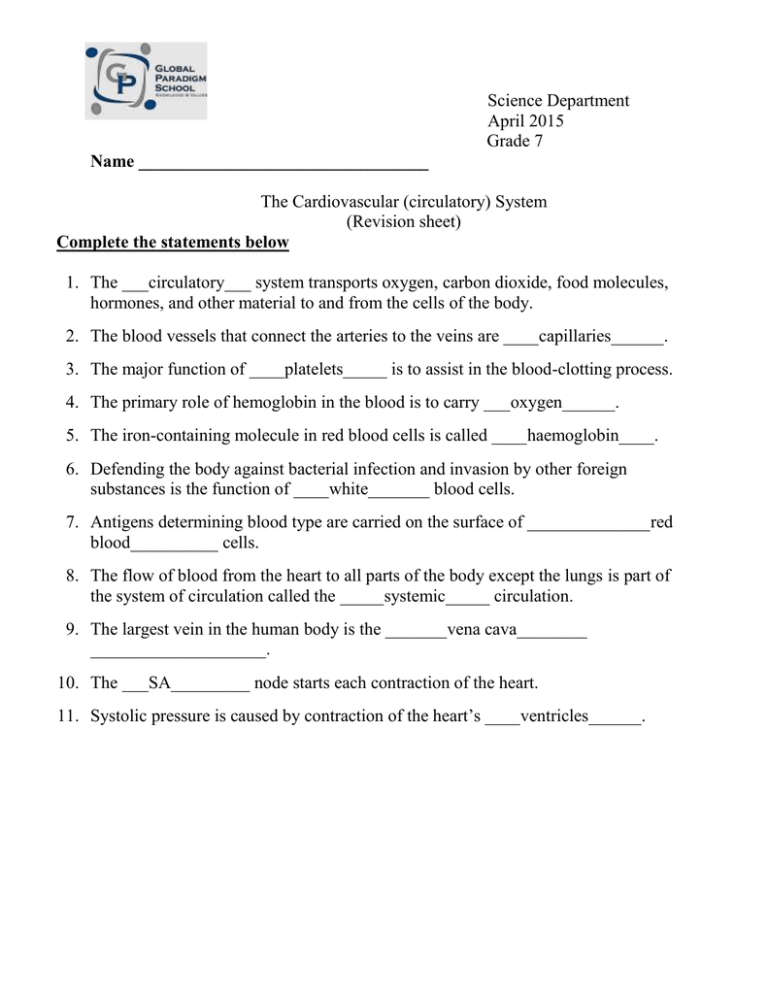
Science Department April 2015 Grade 7 Name _________________________________ The Cardiovascular (circulatory) System (Revision sheet) Complete the statements below 1. The ___circulatory___ system transports oxygen, carbon dioxide, food molecules, hormones, and other material to and from the cells of the body. 2. The blood vessels that connect the arteries to the veins are ____capillaries______. 3. The major function of ____platelets_____ is to assist in the blood-clotting process. 4. The primary role of hemoglobin in the blood is to carry ___oxygen______. 5. The iron-containing molecule in red blood cells is called ____haemoglobin____. 6. Defending the body against bacterial infection and invasion by other foreign substances is the function of ____white_______ blood cells. 7. Antigens determining blood type are carried on the surface of ______________red blood__________ cells. 8. The flow of blood from the heart to all parts of the body except the lungs is part of the system of circulation called the _____systemic_____ circulation. 9. The largest vein in the human body is the _______vena cava________ ____________________. 10. The ___SA_________ node starts each contraction of the heart. 11. Systolic pressure is caused by contraction of the heart’s ____ventricles______. Label the parts of the heart below Pulmonary artery Superior vena cava aorta Pulmonary arteries Pulmonary veins Left atrium Right atrium Left valve Right valve Left ventricle Right ventricle septum Match the keywords in column A to the statements in column B A B __2___ Arteries 1) pumps blood to entire body __6___ Veins 2) carry blood away from the heart __14__ Capillaries 3) stop you from bleeding to death _18___ Pulse 4) red blood cells-white blood cells-platelets __12__ Aorta 5) pumps blood to lungs __16_ Plasma 6) carry blood to the heart __13___red blood cells 7) delivers oxygen rich blood to every cell in body __3___ Platelets 8) force blood into vessels __19___white blood cells 9) divides heart into two sides __8___ blood pressure 10) receives oxygen poor blood __1___ Heart 11) connects atriums to ventricles 12) branches off the heart and then divides into __10___right atria smaller arteries 13) carry oxygen and carbon dioxide through __17___left atria body __5___ right ventricle 14) tiny vessels __15__ left ventricle 15) most powerful part of heart __7___ left ventricle 16) made mostly of water __11___Valve 17) receives oxygen rich blood ___9__ Septum 18) number of beats per minute ___4__ Blood cells 19) keeps you from getting infections Answer the questions below: 1. Why do we need blood? Blood carries ____oxygen____ and __nutrients______ to all _body cells_____. Cells burn ___food____ in the presence of ___oxygen___ to release ____energy_____. This is a process called cellular___respiration________ . Cellular respiration: ____O2____+___sugar______ ___energy___+___CO2___+_water vapor_ ___CO2____ and ___water vapor____ are wastes that the body needs to get rid of. They are carried by the __blood____ to the ___lungs____ to be excreted during exhalation. 2. What is the importance of the heart? It pumps blood to all body cells it also receives blood that will be sent to the lungs for gaseous exchange 3. What is the importance of blood vessels? They carry blood throughout the body 4. Mention the function of each of the following structures: a. Septum Prevents mixing of oxygenated and deoxygenated blood together. b. Valve Prevents the backflow of blood into atria or veins. c. Artery Carries blood away from the heart. d. Vein Carries blood into the heart. e. Cardiac muscles They help the blood pump the blood. f. Capillaries They connect arteries with veins 5. What is a valve and where are the two places where it is present? It is a structure found in veins and in the heart between the atria and ventricles, it allows blood to move in one direction only. 6. Mention the origin (where it starts) of each blood vessel and where it is heading to: Blood vessel Origin Heading to Aorta Left ventricle All body cells Pulmonary vein Lungs Left atrium Pulmonary artery Right ventricle Lungs Vena cava All body cells Right atrium 7. What is the difference between the blood on the right side of the heart and the blood on the left side of the heart? Right side of the heart carries deoxygenated blood which Is blood rich in CO2_while the left side of the heart carries oxygenated blood which is blood rich in O2. 8. Compare between the two types of circulation in our body: Circulation Systemic Pulmonary Definition Blood circulating Blood circulating between the heart and between the heart and all body cells except the lungs the lungs Distance (longer/shorter) longer Shorter

